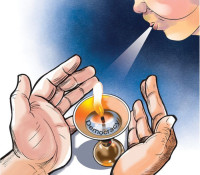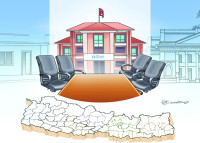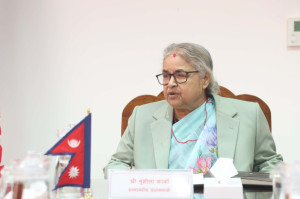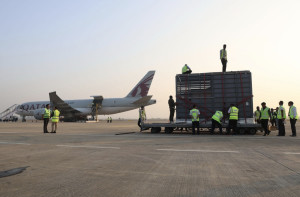Columns
Chandipura virus in Nepal
There is an urgent need for active surveillance of this highly fatal infectious disease.
Dr Sher Bahadur Pun
Chandipura was first detected in Nepal in 2015. The Epidemiology and Disease Control Division (EDCD) confirmed that six out of the 25 acute encephalitis syndrome (AES) cases reported during epidemiological week 48 were caused by the virus. These cases were reported from the districts of Morang, Sunsari, Saptari and Makwanpur. Since then, there have been no official reports of Chandipura virus in the country. However, this does not rule out the possibility of its re-emergence. Sandflies, the known vector responsible for this virus, are well established in the country. So, it is imperative to discuss the significance of the threat posed by the virus in Nepal.
Chandipura virus belongs to the family Rhabdoviridae, which also includes the rabies virus, although the two are classified under separate genera. The clinical manifestations include the sudden onset of high-grade fever, seizures, altered sensorium, diarrhoea, vomiting, often followed by death in the majority of reported cases. The virus primarily targets the brain, causing a form of encephalitis (swelling of the brain), and is thus known as the “brain-killing virus”. Most reported fatalities occurred within 48 hours of the onset of the symptoms. Observational data suggest that approximately 7.5 out of every 10 infected individuals succumbed to the illness. The disease primarily affects children aged 15 and below. In Nepal, although the EDCD confirmed cases of Chandipura virus, there are no documented fatalities attributed to its complications, an outcome that seems highly unlikely.
The primary vector for the Chandipura virus, sandflies, are also responsible for the transmission of visceral leishmaniasis (also known as Kala-azar), a disease that has been endemic in Nepal for a long time. Historically, visceral leishmaniasis was mainly restricted to the southern parts of the country. However, in recent years, several studies have reported cases of autochthonous visceral leishmaniasis in the hilly and even the Himalayan regions of Nepal. This emerging trend may also indicate a potential risk for Chandipura virus in these areas. However, no human-to-human transmission of the virus has been reported to date.
The World Health Organisation (WHO) defines acute encephalitis syndrome (AES) as the sudden onset of fever, either a change in mental status (including symptoms such as confusion, disorientation, coma or inability to communicate) and/or the new onset seizures (excluding simple febrile seizures) in individuals of any age occurring at any time of the year. AES can happen in a variety of neurotropic diseases, including Japanese encephalitis (JE). Studies suggest that in Nepal, the JE virus accounts for only 5 to 20 percent of AES cases, while nearly 75 percent remain of unknown aetiology. Similarly, another study conducted in Nepal reported that only 4.7 percent of AES cases tested positive for the JE virus, meaning that a significant proportion of AES cases remain undiagnosed, perhaps due to the lack of advanced diagnostic laboratories.
Given the widespread presence of sandflies, particularly in the Terai regions, the Chandipura virus should be included in routine laboratory testing for patients presenting with symptoms similar to those of AES. Laboratory tests such as reverse transcription polymerase chain reaction (RT-PCR) and serology tests are helpful in identifying Chandipura virus infection, enabling healthcare workers to initiate supportive treatment and implement timely public health interventions. So far, there are no definitive antiviral drugs available for its treatment. Given the rapid progression of the disease, its high fatality rate and the absence of specific antiviral drugs, vaccination appears to be the most viable strategy to avert possible outbreaks. However, at present, it is regrettable that a vaccine for commercial use is currently unavailable.
Serological testing within the population can be beneficial in understanding the current situation or the potential silent spread of the virus. Similarly, the Enzyme-Linked Immunosorbent Assay (ELISA) test is a simple, relatively inexpensive and effective method that can be used for patients with fever and symptoms suggestive of AES when the causative agent is unknown. In India, for example, human samples collected between 1955 and 1965 from different parts of the country showed the presence of antibodies against Chandipura virus in both humans and domestic animals, indicating past exposure or infection.
Likewise, although there weren’t any reported human outbreaks, antibodies were also detected in wild macaques (Macaca sinica) in Sri Lanka. Therefore, conducting serological studies from the southern plains to the Himalayan regions of Nepal is crucial. The potential for spillover from animals into human communities or the emergence of sudden outbreaks cannot be ruled out. For instance, India experienced an unprecedented outbreak of Chandipura virus between early June and mid-August 2024, during which 245 cases of AES were reported, including 82 deaths (33 percent). This was reportedly the largest outbreak in the last 20 years, despite the virus being considered endemic and associated with recurrent outbreaks in the country.
Given the recurring outbreaks of the virus in neighbouring country India, the possibility of its re-emergence in Nepal cannot be underestimated. As a highly fatal infectious disease, there is an urgent need for active surveillance, including at least a baseline study in both human and animal populations. Such efforts will be crucial for developing a timely and effective action plan to contain any future outbreaks.
Pun is the Chief of the Clinical Research Unit at Sukraraj Tropical and Infectious Disease Hospital.




 5.14°C Kathmandu
5.14°C Kathmandu















